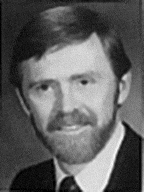


Editorial
Editorial

In honor of the IUCr's launching of the new Journal of Synchrotron Radiation, edited by John Helliwell, this issue of the IUCr Newsletter features a 9 page section on Synchrotron Radiation as well as items on Synchrotron Radiation in the Meeting Reports and Resources departments. Because of our 32 page limit, the emphasis on Synchrotron Radiation has made it necessary to delay publication of several submitted articles, meeting reports, notices, calendar, and resource items. We will try to catch up in the first issue of 1995. Readers who can access the World Wide Web (WWW) will find material taken from future IUCr Newsletters and additional information about coming events including the 1996 IUCr Congress and General Assembly on the ACA homepage of WWW. The ACA, a regional affiliate of the IUCr, is on WWW at http://nexus.hwi.buffalo.edu/aca/ or it can be accessed at: http://www.cisti/nrc.ca/ACA95/welcome.html.
The most recent issue of the ACA Newsletter contains seven pages of reminiscences about Dorothy Hodgkin by Jenny Glusker, Ken Trueblood, and Shekhar Mande and about Linus Pauling by Jack Dunitz, Dick Marsh, and Vernon Schomaker. I regret that we cannot reprint all of them as well as wonderful tributes by Guy Dodson and Max Perutz that appeared in British newspapers. A condensed version of Jack Dunitz's reminiscence about Linus is reprinted in this issue. The entire content of the most recent issue of the ACA Newsletter, including the six pages of stories and photos concerning the lives of Hodgkin and Pauling and 20 pages covering the ACA meeting in Atlanta, can be accessed on the ACA homepage of WWW. An article in the Nov.-Dec. issue of American Scientist, Vol. 82, contains an interview with Pauling last April. In response to an enquiry about his positive outlook on life, Linus said "Oh, I suppose it's perhaps partially genetic ... actually the result of my having been pretty successful in my own career, and of course, my feeling that we ought to be smart enough, we human beings, to solve our problems, whatever they are."
Make that 28!
In an article in Vol. 2, No. 1 of the Newsletter, G. A. Jeffrey identified the 26 Nobel Laureates associated with crystal diffraction. On October 13, the 1994 Nobel Prize in physics was awarded to Clifford Shull of MIT in Boston and Bertram Brockhaus of McMaster University in Hamilton, Ontario. Shull is cited for the development of instrumentation for crystallographic analysis by neutrons. He has been a member of the ACA for over 35 years and is listed in the 1990 World Directory of Crystallography. Brockhaus developed the field of inelastic neutron scattering using the triple axis neutron spectrometer he developed at Chalk River.
Reality based science
The value and validity of science is being questioned with ever greater intensity. If you are not aware of the controversy surrounding the recently published "Higher Superstition; The Academic Left and Its Quarrels with Science" by P. C. Gross and N. Levitt, Johns Hopkins University Press, or the challenge to reality-based science presented by a relativist philosophy of science with its politically correct overtones and implications, you might do well to read the book by Gross and Levitt or correspondence and reviews related to it and the questions it raises in Physics Today (June, 1994, p. 15), Science (August 12, 1994, p. 853), or The Scientist (November/December, 1994, p. 39). In his tribute to Max Perutz on the occasion of Perutz' 80th birthday (Structure, October 1994, p. 901) Paul Sigler eloquently identifies crystallographic research as the quintessential example of reality-based research when he states "there is simply no way that one can bias the design of such an experiment (crystallographic) with one's preconceptions. Myoglobin at 2 Å looks like myoglobin at 2 Å regardless of what you thought it might look like."
Hot stuff
Crystal structures are showing up in the Hot Papers column in The Scientist newspaper with increasing regularity. Articles cited in the column are those that are less than two years old and that have received a substantially greater number of citations than others of the same topic and vintage. Recent entries include "Crystal structure of two viral peptides in murine MHC class I H-2Kb" (D. H. Fremont, M. Matsumura, E. A. Stura, P. A. Peterson and I. A. Wilson, Science 257, 919-27, 1992) and "Crystal structure of Src-homology 3(SH3) domain" (A. Musacchio, M. Noble, R. Pauptit, R. Wierenga and M. Saraste, Nature 359, 851-855, 1992).
Changes
Since 1985 the ACA office has been housed at the Medical Foundation of Buffalo (MFB). Since the fall of 1993, the editor's office of the IUCr Newsletter has been sharing space with the ACA office at the MFB. On October 5, 1994 the MFB changed its name and became the Hauptman-Woodward Medical Research Institute (HWI).
For the past two years, advertising in the IUCr Newsletter has been managed through the offices of the AIP. Beginning with the next issue, the first of 1995, all advertising will be managed through the editorial office in Buffalo. Matters pertaining to advertising should be addressed to W. L. Duax or Patti Coley.
Who was that really?
Howard Flack's hiking partner on p. 27 of Vol. 2, No. 3 was Syd Hall, not D. A. Rae. Mel Fehlman points out that the first Ewald prize was shared by John Cowley and Alex Moodie. Ted Prince wrote that in the picture of the Acta Cryst. editors (Vol. 2, No.3, p. 15) the fifth person from the left in the second row is K. Muir not M. Hart and that in the back row beginning from the left, the editors are P. Lindley, D. Schwarzenbach, M. Harding, H. Steinfink, and J. I. Langford. Dieter Schwarzenbach and others caught the misspellings of Simonov and Pascardin. Apologies to all.


